The Election of the President Throughout U.S. History
Part 5: 1900 to 1924 The Election of 1900 Bryan's campaign for Free Silver did not have as much sway with voters because the economy was booming again. The election results were much the same as the first contest between the two men, with McKinley handily winning both popular and electoral votes, the latter 292-155. Utah had joined the Union by this time, and its three electoral votes went to McKinley. One other change of note was that McKinley's running mate had changed. His Vice-president, Garret Hobart, had died in 1899; for the election, the Republicans chose former New York Gov. Theodore Roosevelt, who was by then a very popular because of his war heroics in the Spanish-American War. The Election of 1904 He was indeed chosen to run again, and his Democratic opponent was Alton B. Parker, the Chief Judge of the New York Court of Appeals. The two candidates were so similar in political outlook that most voters couldn't find a reason to part with Roosevelt, especially since his wartime experience in the Spanish-American War was still very much a part of the collective memory. The result was a landslide re-election, with the President claiming 336 electoral votes to the challenger's 140. Roosevelt won Missouri, the first Republican candidate to do since 1868. The Election of 1908
Looking to change tactics, the Democratic Party returned to their former champion, Bryan. The hope was that he could regain some of the magic he captured in his previous two candidacies. The result in Bryan's third go at the presidency was even more decisive, with Taft winning in a runaway, 321-162. Oklahoma had been admitted to the Union in this year, and Bryan captured the new state's seven electoral votes, but it wasn't nearly enough. The Election of 1912 The Democrats lined up behind New Jersey Gov. Woodrow Wilson, and Wilson won a decisive victory, capitalizing on the split Republican vote. Wilson's 435 electoral votes were the most ever up to that time. Roosevelt finished in second, with 88 votes. Taft won only two states, totaling 8 electoral votes. The admission of Arizona and New Mexico into the Union in 1912 completed the continental U.S. A majority of voters in both states supported Wilson. The Election of 1916 The election proved to be an extremely close electoral contest. Wilson, despite outdistancing Hughes by nearly 6 million votes, nonetheless very nearly lost the electoral count. His 30 states totaled 277 votes in the Electoral College, just more than the majority needed to win. Hughes' 18 states totaled 254. Wilson thus became the first Democratic President since Andrew Jackson to win re-election. A year later, American forces officially entered World War I. The "doughboys" went to the fronts in France, lending much-needed muscle to the efforts to fight back the armies of Germany, Austria-Hungary, and the Ottoman Empire. The Election of 1920 The Republican candidate was Ohio Sen. Warren G. Harding, whose campaign slogan of "A Return to Normalcy" resonated strongly with a great many frightened, disillusioned voters. Harding won a landslide victory, besting Cox by 7 million popular votes and an electoral tally of 404-127. It was the most lopsided popular vote victory in history. This election was also notable because it was the first in which American women had the legal right to vote in all 48 states. Americans had ratified the Nineteenth Amendment on Aug. 18, 1920. The popular vote in this election increased from 18.5 million four years before to 26.8 million. Harding's running mate was Calvin Coolidge, the governor of Massachusetts. The Election of 1924
With no wars either at home or abroad and the economy going along at a good clip, Coolidge had no trouble being re-elected, outdistancing his Republican opponent, John W. Davis, 382-136. Coolidge won everything but the "Solid South" and Oklahoma. Wisconsin favorite son Robert La Follette ran on the Progressive ticket in this election and carried his home state. |
|
Social Studies for Kids
copyright 2002–2024
David White

 The situation was much the same four years later, as McKinley again squared off against Bryan, with the incumbent enjoying a return to economic prosperity and a victory in the Spanish-American War.
The situation was much the same four years later, as McKinley again squared off against Bryan, with the incumbent enjoying a return to economic prosperity and a victory in the Spanish-American War. 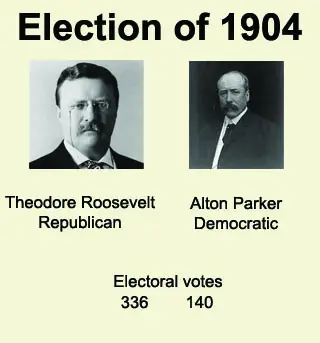 Roosevelt became President when McKinley was assassinated, in 1901, and served out the remainder of the presidential term. As the 20th Century dawned, the American economy chugged along, buoying Roosevelt's chances for re-election.
Roosevelt became President when McKinley was assassinated, in 1901, and served out the remainder of the presidential term. As the 20th Century dawned, the American economy chugged along, buoying Roosevelt's chances for re-election. 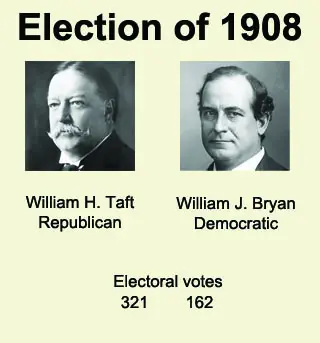 Even though he remained quite popular as President and the American economy and standing remained strong, Roosevelt honored his promise not to seek re-election and stepped aside in 1908.
Even though he remained quite popular as President and the American economy and standing remained strong, Roosevelt honored his promise not to seek re-election and stepped aside in 1908. Roosevelt was vocal in supporting the candidacy of Secretary of War
Roosevelt was vocal in supporting the candidacy of Secretary of War 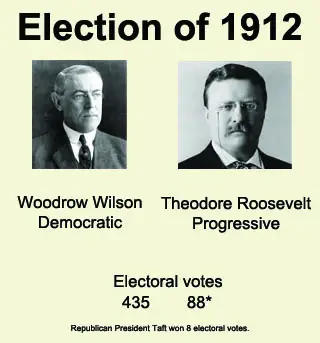 Roosevelt had handed over his legacies and his policies to Taft, but the two increasingly did not see eye-to-eye on the future of the country. Taft increasingly sided with big business and the more conservative wing of the Republican Party. Roosevelt by nature was more affiliated with the
Roosevelt had handed over his legacies and his policies to Taft, but the two increasingly did not see eye-to-eye on the future of the country. Taft increasingly sided with big business and the more conservative wing of the Republican Party. Roosevelt by nature was more affiliated with the 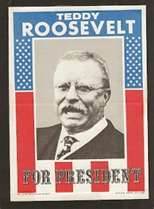 progressive wing of the party. After the Republican National Convention nominated Taft for re-election, Roosevelt left to form his own organization, the Progressive Party. (Its nickname was the "Bull Moose Party.") Roosevelt declared himself a candidate for President, as head of this new party.
progressive wing of the party. After the Republican National Convention nominated Taft for re-election, Roosevelt left to form his own organization, the Progressive Party. (Its nickname was the "Bull Moose Party.") Roosevelt declared himself a candidate for President, as head of this new party.  The election of 1916 took place in the middle of World War I. Promising continued neutrality, Wilson ran for re-election on the slogan of "He Kept Us Out of War." His opponent was Supreme Court Justice Charles Evan Hughes, who ran a very strong anti-war campaign. There was the strong suspicion among many in the country that war could not be avoided, especially since the sinking of the Lusitania a year before the election.
The election of 1916 took place in the middle of World War I. Promising continued neutrality, Wilson ran for re-election on the slogan of "He Kept Us Out of War." His opponent was Supreme Court Justice Charles Evan Hughes, who ran a very strong anti-war campaign. There was the strong suspicion among many in the country that war could not be avoided, especially since the sinking of the Lusitania a year before the election.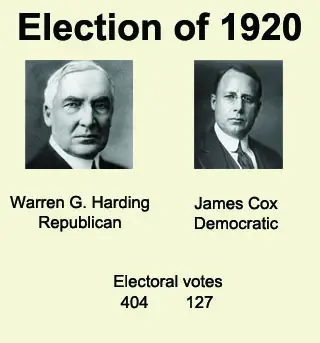 World War I ended in 1918 and was followed by a period of worldwide economic depression. Wilson's postwar policies, including the establishment of the League of Nations, proved unpopular with many in Congress and in America as a whole. Major strikes in heavy industry and large-scale race riots in large cities had many in the U.S. on edge. Wilson did not run again, and the Democratic Party nominated Ohio Gov. James M. Cox (whose running mate was a young Franklin D. Roosevelt).
World War I ended in 1918 and was followed by a period of worldwide economic depression. Wilson's postwar policies, including the establishment of the League of Nations, proved unpopular with many in Congress and in America as a whole. Major strikes in heavy industry and large-scale race riots in large cities had many in the U.S. on edge. Wilson did not run again, and the Democratic Party nominated Ohio Gov. James M. Cox (whose running mate was a young Franklin D. Roosevelt).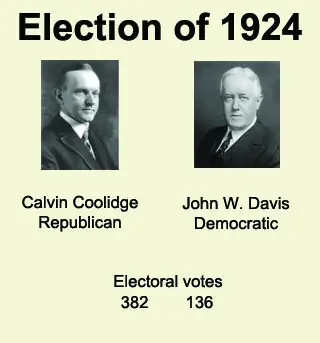 When Harding died in 1923, Coolidge became President. He carried on Harding's pro-business policies, famously saying that "The business of America is business." Coolidge was also famous for not saying a whole lot else.
When Harding died in 1923, Coolidge became President. He carried on Harding's pro-business policies, famously saying that "The business of America is business." Coolidge was also famous for not saying a whole lot else. 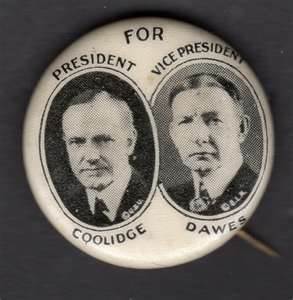 When running again, he didn't really need to make a whole lot of announcements. Business, big and small, was booming. (Although they didn't know it yet, the Republicans' policies were not addressing the fundamental problems that, in part, led to the Great Depression.)
When running again, he didn't really need to make a whole lot of announcements. Business, big and small, was booming. (Although they didn't know it yet, the Republicans' policies were not addressing the fundamental problems that, in part, led to the Great Depression.)
